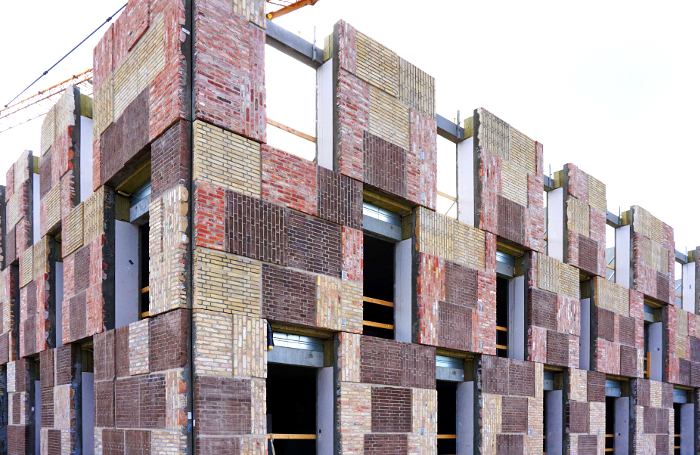“I have spent many years trying to convince clients, or sometimes almost trick them, into making a project more sustainable,” reveals Ron Bakker, Director and Co Founder of PLP Architects. “It still feels a little strange to experience clients requesting sustainability.”
“But thankfully the whole market is slowly shifting in that direction. This is now a service that architects must be able to provide: it is becoming an expectation, not an option.”
With PLP, Bakker carries out a great deal of work in the Netherlands. Bakker is effusive about the Dutch construction industry’s collaborative attitude towards sustainability.
There is what he describes as an “activist market perspective” that achieves buy-in from clients and contractors. He cites as an example the well established company New Horizon, who are specialists in ‘urban mining’ and the largest suppliers of such reused materials in the world. They dismantle buildings with the aim of harvesting as many materials as possible for reuse, regarding every building as a donor of parts.
“They have linked demolition firms up with the construction materials market extremely cleverly,” Bakker enthuses. “Contractors acknowledge they must have better green credentials and are working with New Horizon. They see their peers using them and they want in.”
Supply chain innovations of this kind are also taking place in the UK. ReLondon is a partnership of London’s boroughs that aims to improve resource management and publishes a guide to Sourcing reclaimed construction materials.
This guide includes tips on using online exchange platforms and profiles suppliers such as: Globechain, Enviromate, Salvo, Cleveland Steel & Tubes and Community Wood Recycling . Many of these are reuse marketplaces that connect enterprises, businesses and individuals with each other to buy, sell or donate leftover building materials. Globechain even generates ESG data on the impact of a donor’s redistribution of an item.

Another valuable resource - and further evidence of pan-industry collaboration - is the Accelerating material reuse programme that developers Grosvenor are engaged in. It partnered with architects HETA and Orms and engineers Elliott Wood and ARUP to research practical ways to make construction more of a circular economy.
It has produced guidance on deconstructing buildings for circular use, information on how materials passports could work and the practicalities of using reclaimed materials. It has also set up a re-use network: a mailing list for those with specific materials to contribute and those who need them.
Steve Gilchrist, Project Director at Grosvenor and instrumental to its Accelerating Material Reuse programme, points to UK-based deconstruction experts such as McGee who are able to process and divert 98% their waste from operations from landfill. Gilchrist states that Grosvenor’s initiative caught the attention of EMR (Euro Metals Recycling), who can recycle steel and scrap metal for reuse.
Contractors are also noticing an increasing awareness of circular economy across the industry. Anna Foden is Head of Sustainability within the Fit Out team at construction and engineering company ISG.
“More and more we are seeing a big push to reuse as much as possible: either reusing it in situ or packaging it up onsite for reuse elsewhere,” Foden states.
She cites the aforementioned Globechain but also Collecteco as providers of useful reuse and rehoming services.
In one project in 2020, a Category A fitout, ISG stripped out more than 1.000 new LED lights and sent them back to the manufacturer to be re-warranted.
“They are now in a warehouse waiting to be rehomed in a new project at Cambridge University,” Foden explains. “Storage is often a challenge, but one that many supply chain partners are rising to.”
Another challenge lies in convincing the client that not everything has to be brand new, Foden continues. But she believes they are increasingly coming round.
“For the same fitout we were able to reuse a huge integrated reception desk from another project. We stripped it out, and found the original joinery company who resized it so we could reinstall it. Ultimately we would like to be part of a large network of reuse opportunities.”
Ron Bakker will be speaking at this year’s RIBA Future Leaders: Business & Innovation conference on 8 June 2022. Tickets are available now.
Thanks to Ron Bakker, Director and Co Founder, PLP Architecture; Anna Foden, Head of Sustainability, ISG; Steve Gilchrist, Project Director, Grosvenor.
Text by Matt Milton. This is a Professional Feature edited by the RIBA Practice team. Send us your feedback and ideas
RIBA Core Curriculum topic: Sustainable Architecture.
As part of the flexible RIBA CPD programme, professional features count as microlearning. See further information on the updated RIBA CPD core curriculum and on fulfilling your CPD requirements as an RIBA Chartered Member.
First published Thursday 31 March 2022









